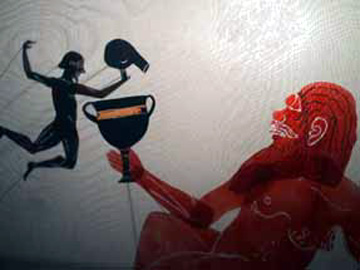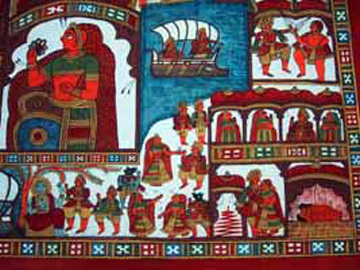Letter from New York
23
February 2004.
Copyright © 2004 by
Mindy Aloff
 For
the past 25 years, Theodora Skipitares has been making award-winning spectacles
of puppetry, using techniques from around the world. The several productions
of hers that I’ve seen tend to be optically spellbinding and aurally
almost unendurable. Her scripts are disorganized and banal, the voices
of her actors aren’t very interesting, and the minimalist electronic
scores she uses, often for 70 minutes at a stretch, cancel out the delights
that come in through the eye. What she really needs, from my perspective,
is to present her puppetry in silence, with dialogue streaming electronically
somewhere visible.
For
the past 25 years, Theodora Skipitares has been making award-winning spectacles
of puppetry, using techniques from around the world. The several productions
of hers that I’ve seen tend to be optically spellbinding and aurally
almost unendurable. Her scripts are disorganized and banal, the voices
of her actors aren’t very interesting, and the minimalist electronic
scores she uses, often for 70 minutes at a stretch, cancel out the delights
that come in through the eye. What she really needs, from my perspective,
is to present her puppetry in silence, with dialogue streaming electronically
somewhere visible.
And yet,
when she triumphs, one is knocked out with pleasure. There was one scene
in Skipitares’s new production, Odyssey: The Homecoming,
which I saw at La MaMa e.t.c. yesterday, that was worth the effort to
go. Odyssey: The Homecoming attempts to retell Homer’s
story and also to connect it to that of the returning veterans from the
Vietnam War. The moment of glory, however, was when Odysseus—a handsomely
formed fabric puppet with a wonderful face bearing an  expression
of open astonishment, who was half life-sized and who, somewhat in the
manner of Bunraku, was worked by two hooded puppeteers in black—was
recognized by his old nurse on the beach as she washes his body, battered
by the waves. The nurse, who is twice the puppet’s size, is played
by another puppeteer in black, wearing an outsized mask-head of a withered
face. We saw the Odysseus puppet pull himself to a sitting position on
a rock, saw his slow reaction of intense feeling as he realized that the
nurse had recognized him from a childhood scar, and then saw him extend
his hands, the fingers articulated, in a restrained gesture of acceptance
and love. To get a puppet to make the simplest, most everyday movement—with
the transitions between actions—is a kind of virtuosity that takes
away the breath of the most jaded observer. At this moment, in fact, there
was choreography of three kinds: that for the puppet, that of the people
working the puppet, and that of the nurse. Skipitares has made a career
of puppet-plays with strong social and cultural messages: I wish she would
let go of the messages and follow the puppetry into dreams.
expression
of open astonishment, who was half life-sized and who, somewhat in the
manner of Bunraku, was worked by two hooded puppeteers in black—was
recognized by his old nurse on the beach as she washes his body, battered
by the waves. The nurse, who is twice the puppet’s size, is played
by another puppeteer in black, wearing an outsized mask-head of a withered
face. We saw the Odysseus puppet pull himself to a sitting position on
a rock, saw his slow reaction of intense feeling as he realized that the
nurse had recognized him from a childhood scar, and then saw him extend
his hands, the fingers articulated, in a restrained gesture of acceptance
and love. To get a puppet to make the simplest, most everyday movement—with
the transitions between actions—is a kind of virtuosity that takes
away the breath of the most jaded observer. At this moment, in fact, there
was choreography of three kinds: that for the puppet, that of the people
working the puppet, and that of the nurse. Skipitares has made a career
of puppet-plays with strong social and cultural messages: I wish she would
let go of the messages and follow the puppetry into dreams.
Also this
past weekend, Barnard College and Columbia University hosted a remarkable
program on the music and dance of India: “Contesting Pasts, Performing
Futures: Nationalism, Globalization, and the Performing Arts in Modern
South Asia” (the 2004 Barbara Stoler Miller Conference). I wasn’t
able to get to the live performance; however, the academic session I attended
was passionate and brainy—and filled with people who were agreeing
on disagreeing about the discrepancy between theory and practice. The
paper topics and their presenters are listed below; yet I’d like
to note that the films of Orissi dancing presented by Ratna Roy of Evergreen
State College were among the most amazing dance performances I’ve
seen in New York this year. They included a teenager who tossed off bourrées
on half-toe that were so perfectly matched they seemed to speak; five
boys (ages 9 to 15) trained to dance Orissi using a feminine technique,
who were so good that someone from the audience asked their gender; and
an 86 year-old Orissi diva, who danced while seated, as, according to
Professor Roy, she had a temperature of 102 on the day she was filmed.
Common to all of them was an ease of execution that made their dancing
look as natural as breathing, regardless of the difficulty of the choreography
or its demands on stamina. It’s good to be reminded that there are
still dancers in the world who dance like that.
--Mindy Aloff
(Photographs by Chris
Maresca)
First: Shadow-puppet images of Odysseus (black figure) confronting Cyclops
Second: Detail from Rajasthani scroll painting of The Odyssey,
by the brothers Rajesh Kumar Bhopa and Shankar Kumar Bhopa, commissioned
for Odyssey: The Homecoming
Casting and
production credits:
Odyssey: The Homecoming
Dedicated to Michael P. Moran
12-29 February
The Annex at La MaMa e.t.c.
Conceived, Designed, and Directed by Theodora Skipitares
Composers: Arnold Dreyblatt, Tim Schellenbaum
Lighting: Pat Dignan
Video: Kay Hines
(Fragment of film from Spartacus, directed by Stanley Kubrick)
Dramaturgy: Andrea Balis
(Fragments of text drawn from Homer’s Odyssey, Robert Graves’s
The Fall and Sack of Troy, Gothics News Service, Jonathan Shay’s
Odysseus in America)
Technical Design: David Adams
Scenic Artists: Jen Harris, Eva Landsberry (model of Walter Reed Army
Hospital), Ronnie Lin (Odysseus video animation), Bernadette Witzack
Choreography: Alissa Mello
Stage Manager: Chris Mehmed
Storyteller: (Penelope) Meredith Wright
Puppeteers: Bronwen Bitetti, Deborah Herzberg, Michael T. Kelly, Chris
Maresca, Alissa Mello, Amanda Villalobos, Bernadette Witzack
Voices: (on tape) Michael Arian, Andrea Balis, Raine Bode, Taylor Mac
Bowyer, Agosto Machado, Nicky Paraiso, Zishan Ugurlu; (Odysseus puppet)
Cathy Shaw; (Zeus on video) Christopher James; (Athena on video) Sarah
Stern
List of Scenes:
Prologue: This is the story of Odysseus
Scene 1: Athena and Zeus
Scene 2A: Walter Reed Army Hospital
Scene 2B: The Returns
Scene 3: Childhood
Scene 4: A Strange Shore
Scene 5: Lotus-Eaters
Scene 6: Cyclops
Scene 7: Circe
Scene 8: Land of the Dead
Scene 9: The Recognition
Scene 10: The Battle for Home
Epilogue
Contesting
Pasts, Performing Futures: Nationalism, Globalization, and the Performing
Arts in Modern South Asia
(The 2004 Barbara Stoler Miller Conference)
20-22 February
Cosponsored by the Department of Asian & Middle Eastern Cultures and
the Provost’s Office at Barnard College; and the Southern Asian
Institute, Columbia Arts Productions, Department of Middle East &
Asian Languages and Cultures,
and the Center for Comparative Literature & Society at Columbia University
21 February
405 Milbank Hall, Barnard College
“Institutions and canons: Constructions of the ‘classical’
performing arts in South Asia in the 19th and 20th centuries”
Chair: Rachel McDermott (Asian & Middle Eastern Cultures, Barnard
College)
Papers:
“Odissi Dance: Imagined Past, Reconstructed History, Monolithic
Future?,” by Ratna Roy (Expressive Arts, Evergreen State College)
“Two Faces of Music: V.D. Paluskar and V.N. Bhatkhande,” by
Janaki Bakhle (Middle East & Asian Languages & Cultures, Columbia
University)
“Weaving Fragmented Pasts: History, Logic, and Form in the 19th-century
Dance Compositions of the Tanjavur Brothers,” by Hari Krishnan (Dance,
Wesleyan University)
Originally
published:
www.danceviewtimes.com
Volume 2, Number 8
February 23, 2004
Copyright © 2004 by Mndy Aloff
|
|